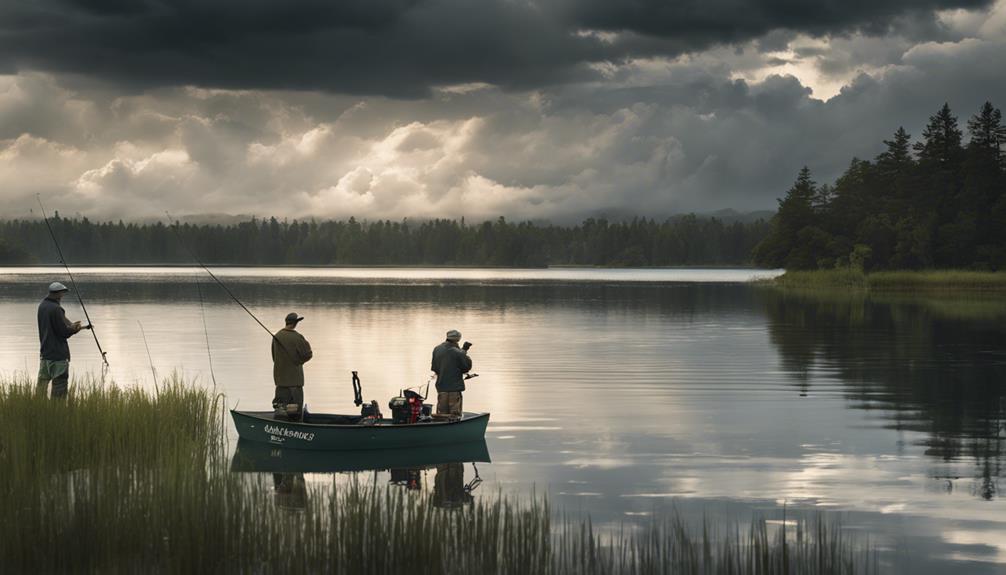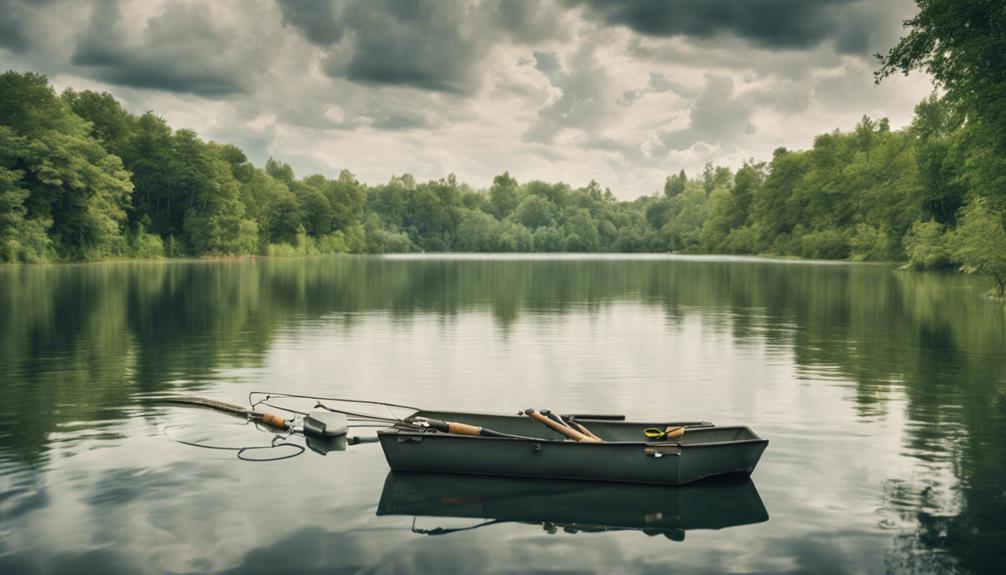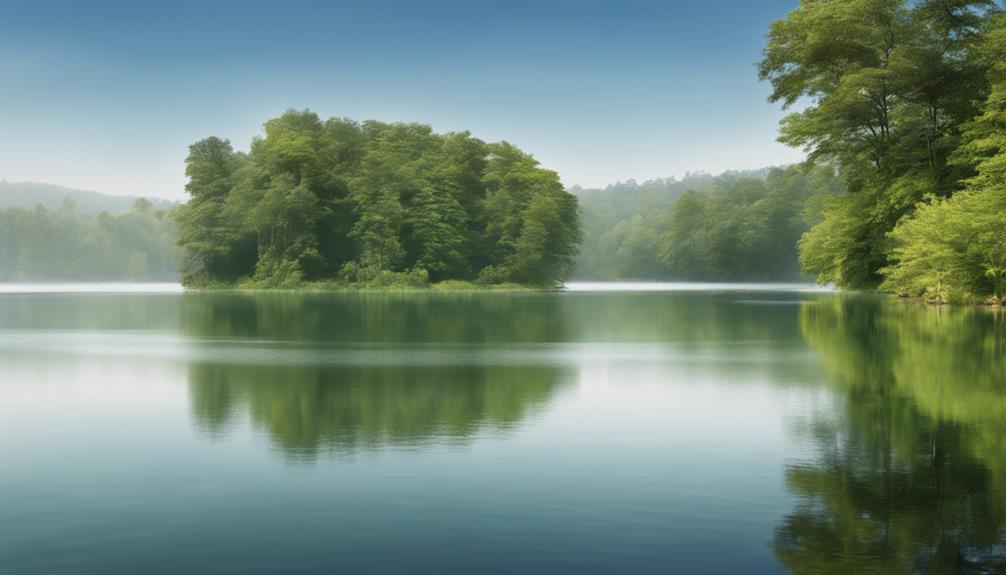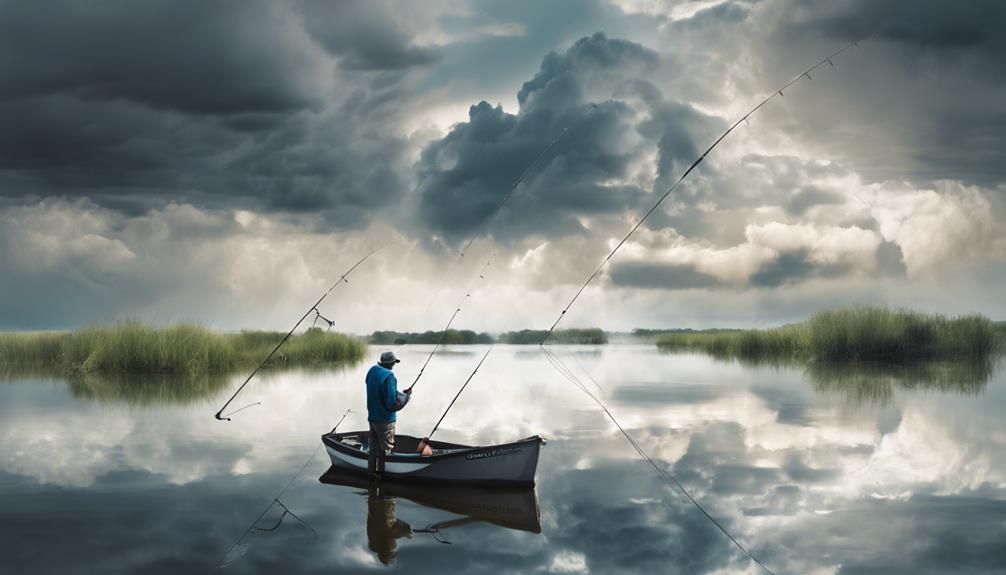Weather impacts competitive fishing tournaments by influencing fish behavior, catch rates, and angler strategies. Barometric pressure determines fish depth, affecting catch rates. Wind speed alters fish navigation, guiding anglers to sheltered spots. Cloud cover affects fish activity levels, prompting strategy adjustments. Precipitation changes water conditions, requiring anglers to target new fish areas. Water temperature impacts fish metabolism, directing anglers to optimal locations. Air temperature fluctuations influence fish activity. Moon phase and sunlight availability guide angler decisions for better success. Understanding these factors enhances tournament performance. Weather is a key player in the dynamic world of competitive fishing tournaments.
Barometric Pressure
How does barometric pressure affect fishing tournaments, and what data supports its impact on fish behavior and catch rates? Barometric pressure plays a crucial role in determining fishing success in tournaments. When the pressure is high, fish tend to move deeper in the water, making them harder to catch. Conversely, during low-pressure systems, fish are more likely to swim towards the surface, increasing catch rates. Understanding these patterns is essential in shaping tournament strategy.
Data from various fishing tournaments supports the correlation between barometric pressure and fishing success. Analysis of catch rates during different pressure systems reveals that anglers tend to have higher success rates when fishing under low-pressure conditions. This information is pivotal in guiding tournament strategy, as participants can adjust their techniques based on the current pressure readings.
In competitive fishing tournaments, participants closely monitor barometric pressure changes to adapt their fishing methods accordingly. Anglers often target specific depths based on pressure variations to maximize their catch rates. Additionally, incorporating real-time pressure data into tournament strategies provides a competitive edge by allowing anglers to make informed decisions on where and how to fish.
Therefore, barometric pressure significantly influences fish behavior and ultimately impacts catch rates in fishing tournaments. By leveraging data on pressure fluctuations, anglers can enhance their tournament performance and increase their chances of success.
Wind Speed
Wind speed directly impacts fishing tournaments by influencing fish behavior and the difficulty of navigation and casting for anglers. When wind speeds are high, fish tend to seek sheltered areas, affecting where anglers should focus their efforts. Additionally, strong winds can make it challenging for anglers to control their boats, especially in open waters, impacting their ability to reach optimal fishing spots.
In terms of tackle selection, anglers need to consider the wind speed when choosing their equipment. Higher wind speeds can make it harder to use lighter tackle effectively, leading anglers to opt for heavier gear to combat the effects of wind resistance. This adjustment is crucial to maintain control over the line and lure placement.
Boat control becomes paramount in windy conditions. Anglers must constantly adjust their positioning and maneuvering to counteract the wind's force, ensuring they stay on course and can fish effectively. Techniques such as using drift socks or anchors can aid in stabilizing the boat, allowing for more precise casting and improved chances of a successful catch.
Cloud Cover
Cloud cover significantly impacts fishing tournaments by influencing light conditions, fish behavior, and angler strategies. When considering the effect of cloud cover, several key factors come into play:
- Fishing Visibility: Cloud cover can greatly affect the visibility of fish in the water. On overcast days, the reduced sunlight penetration can make it harder for anglers to spot fish, particularly in shallow waters. This decreased visibility may require anglers to adjust their techniques, such as using lures with brighter colors or changing their positioning to account for the lower visibility.
- Fish Behavior: Weather patterns associated with cloud cover, like atmospheric pressure changes, can influence fish behavior. Some species of fish are more active and likely to feed in cloudy conditions, while others may become more lethargic. Understanding how cloud cover affects the behavior of the target species is crucial for anglers to adapt their fishing strategies accordingly.
- Angler Strategies: Cloud cover can prompt anglers to modify their strategies to improve their chances of a successful catch. For instance, during cloudy weather, fish may be more inclined to move into shallower areas or closer to structures for cover. Anglers can capitalize on this behavior by adjusting their bait presentation and targeting specific areas where fish are likely to be congregated.
- Weather Patterns: Cloud cover is often associated with specific weather patterns, such as approaching storms or frontal systems. These weather changes can trigger shifts in fish activity levels and feeding patterns. Anglers must stay informed about upcoming weather conditions to anticipate how cloud cover may evolve throughout the day and adjust their fishing tactics accordingly.
Precipitation
Precipitation plays a crucial role in shaping the outcomes of fishing tournaments by impacting water conditions, fish activity, and angler decision-making strategies. When rain falls during a tournament, it can lead to increased water flow and turbidity. This change in water conditions can affect fish behavior, causing them to move to different depths or locations. Anglers must adapt their fishing techniques to target fish in these new areas. For example, they may need to switch to heavier lures or baits that create more noise to attract fish in murky waters.
Moreover, precipitation can also impact equipment maintenance during fishing tournaments. Rain can lead to increased corrosion on fishing reels and hooks, which may require anglers to clean and lubricate their gear more frequently to prevent damage. Additionally, wet conditions can make lines more prone to tangling or breaking, necessitating adjustments in rigging and knot tying to ensure the equipment functions properly throughout the tournament.
Water Temperature
Water temperature significantly influences the metabolic rates and feeding behaviors of fish, directly impacting their distribution and activity levels during fishing tournaments. Understanding how water temperature affects fish behavior and feeding patterns is crucial for anglers looking to optimize their strategies and techniques during competitions.
- Metabolic Rates: As water temperature changes, so do the metabolic rates of fish. Warmer water increases metabolism, leading to higher energy expenditure and potentially more active feeding behavior. Conversely, colder water decreases metabolic rates, resulting in reduced activity levels and feeding frequency.
- Feeding Behavior: Fish are ectothermic, meaning their body temperature is regulated by external factors like water temperature. Variations in water temperature can trigger different feeding behaviors in fish species. For example, some fish may become more aggressive feeders in warm water, while others may prefer cooler temperatures to feed actively.
- Distribution: Fish tend to move to areas with optimal water temperatures that suit their metabolic needs. During tournaments, anglers should consider the temperature preferences of target fish species to locate them more efficiently. Understanding temperature gradients in water bodies can help anglers identify prime fishing spots.
- Angler Strategies: Knowledge of how water temperature influences fish behavior allows anglers to adapt their strategies accordingly. Adjusting bait presentation, depth of fishing, and lure selection based on water temperature can significantly improve the chances of a successful catch during tournaments.
Air Temperature
Understanding the correlation between air temperature fluctuations and fish behavior is essential for maximizing success in fishing tournaments. Air temperature plays a crucial role in determining water temperature, affecting fish distribution and activity levels. Thermal dynamics dictate that warmer air temperatures lead to an increase in water temperature, which can stimulate fish metabolism and feeding behaviors. On the other hand, a sudden drop in air temperature can cause water temperatures to decrease, potentially slowing down fish activity.
Climate patterns also influence air temperature variations, impacting fishing conditions. Seasonal changes bring about fluctuations in air temperature, influencing the overall fishing experience. During the summer months, higher air temperatures can result in warmer water, leading fish to seek cooler, deeper areas. In contrast, colder air temperatures in winter can cause fish to move to shallower waters where the temperature is relatively warmer.
In competitive fishing tournaments, understanding how air temperature affects fish behavior is crucial for devising effective strategies. Anglers must adapt their techniques based on the prevailing thermal dynamics to increase their chances of success. By monitoring climate patterns and adjusting their approach accordingly, anglers can optimize their fishing efforts and enhance their performance in tournaments. Remember, mastering the relationship between air temperature and fish behavior is key to achieving success on the water.
Moon Phase

The phase of the moon significantly influences fish behavior during fishing tournaments, impacting their feeding patterns and activity levels. Understanding the moon's position in the lunar calendar is crucial for maximizing fishing success. Here's how the moon phase affects competitive fishing tournaments:
- Lunar Calendar: Fish are more active during certain moon phases. For example, during a full moon, fish tend to feed more actively at night. Anglers can leverage this knowledge to adjust their fishing times accordingly, increasing their chances of a successful catch.
- Tidal Patterns: The moon's gravitational pull affects tidal patterns, leading to changes in water movement. Anglers need to be mindful of how these tidal variations influence fish behavior. Fishing during specific tidal phases can enhance angler strategy, as certain fish species are more likely to feed during incoming or outgoing tides.
- Angler Strategy: Experienced anglers often plan their tournament participation based on the moon phase. They may target specific species known to be more active during certain lunar stages. By aligning their strategy with the moon's position, anglers can optimize their chances of a productive fishing tournament.
- Success Metrics: Analyzing historical data on fishing success rates in relation to the moon phase can provide valuable insights for tournament participants. By identifying patterns in fish behavior linked to the lunar cycle, anglers can make informed decisions to improve their performance on competition day.
Sunlight Availability
When considering fishing tournaments, the impact of sunlight availability on fish behavior is a critical factor to examine for strategic planning and increasing the likelihood of a successful catch. Solar radiation plays a significant role in influencing fish activity levels. Fish are ectothermic, meaning their body temperature is influenced by the surrounding environment. Solar radiation heats the water, which in turn affects the metabolism of fish. Increased solar radiation can lead to higher water temperatures, causing fish to be more active and potentially increasing their feeding behavior.
Day length is another key aspect of sunlight availability that affects fish behavior. Changes in day length signal to fish the transition between seasons, influencing their feeding patterns and migration habits. During longer days, fish may have more time for feeding activities, while shorter days could prompt them to conserve energy for colder periods. Understanding the relationship between day length and fish behavior can help anglers predict where fish might be located during different times of the day and adjust their fishing strategies accordingly.
Frequently Asked Questions
How Does the Tournament Location Affect Fish Behavior?
When it comes to how the tournament location affects fish behavior, water temperature plays a crucial role. Fish tend to be more active in water with temperatures that suit their species.
Additionally, the habitat of the location influences fish behavior as they seek out areas that provide shelter and food. Factors like wind direction and currents also impact fish behavior by affecting water flow and creating ideal conditions for feeding or seeking protection.
What Role Do Underwater Structures Play in Fishing Success?
When it comes to fishing success, underwater structures play a crucial role. These features provide shelter for fish, influencing their movement patterns.
Current patterns interact with these structures, creating areas of varying water flow that affect fish behavior. Understanding how fish utilize these structures is key to maximizing your chances of success in a fishing tournament.
Analyzing the relationship between structure and fish movement can give you a competitive edge on the water.
Is There a Specific Time of Day That Fish Are More Active?
During the day, fish tend to be more active during what anglers refer to as the 'morning bite' and the 'evening bite.' These times coincide with low light conditions, making fish less cautious and more likely to feed.
Factors like lunar phases and barometric pressure can also influence fish activity levels during these peak times. Understanding these patterns can help you maximize your chances of a successful fishing expedition.
How Do Different Fish Species Respond to Weather Changes?
Different fish species respond uniquely to weather changes. These variations impact their feeding patterns, habitat preferences, temperature tolerance, and oxygen levels.
For instance, some fish thrive in warmer waters with higher oxygen levels, while others prefer cooler temperatures. Understanding these species-specific behaviors is crucial for successful fishing trips.
How Can Anglers Adapt Their Techniques to Changing Weather Conditions?
When faced with changing weather conditions, anglers must adapt their techniques to maximize success. Consider adjusting bait selection based on the fish's preferences influenced by the weather.
Varying presentation styles can also entice bites. Monitor water temperature and depth as these factors affect fish behavior.
Conclusion
In conclusion, weather plays a crucial role in competitive fishing tournaments. Factors such as barometric pressure, wind speed, cloud cover, precipitation, water and air temperatures, moon phase, and sunlight availability all impact the behavior of fish and ultimately determine the success of anglers.
By closely monitoring these weather conditions and adjusting their strategies accordingly, competitors can increase their chances of catching more fish and achieving victory in tournaments. Weather truly is the ultimate challenge in the world of competitive fishing.



